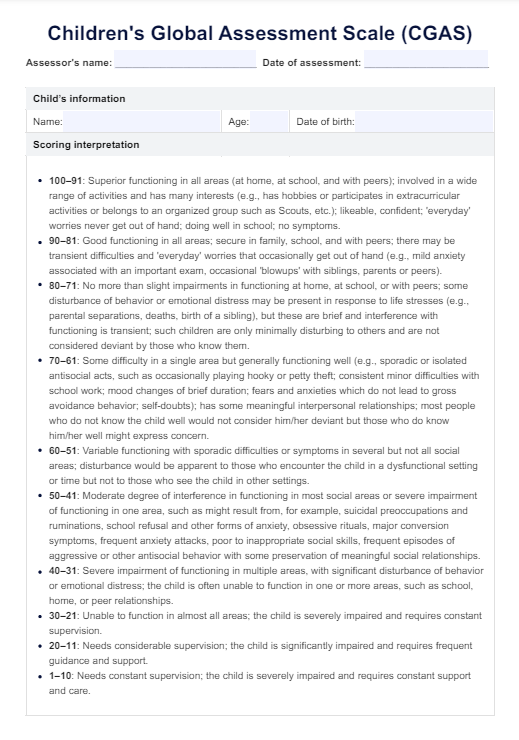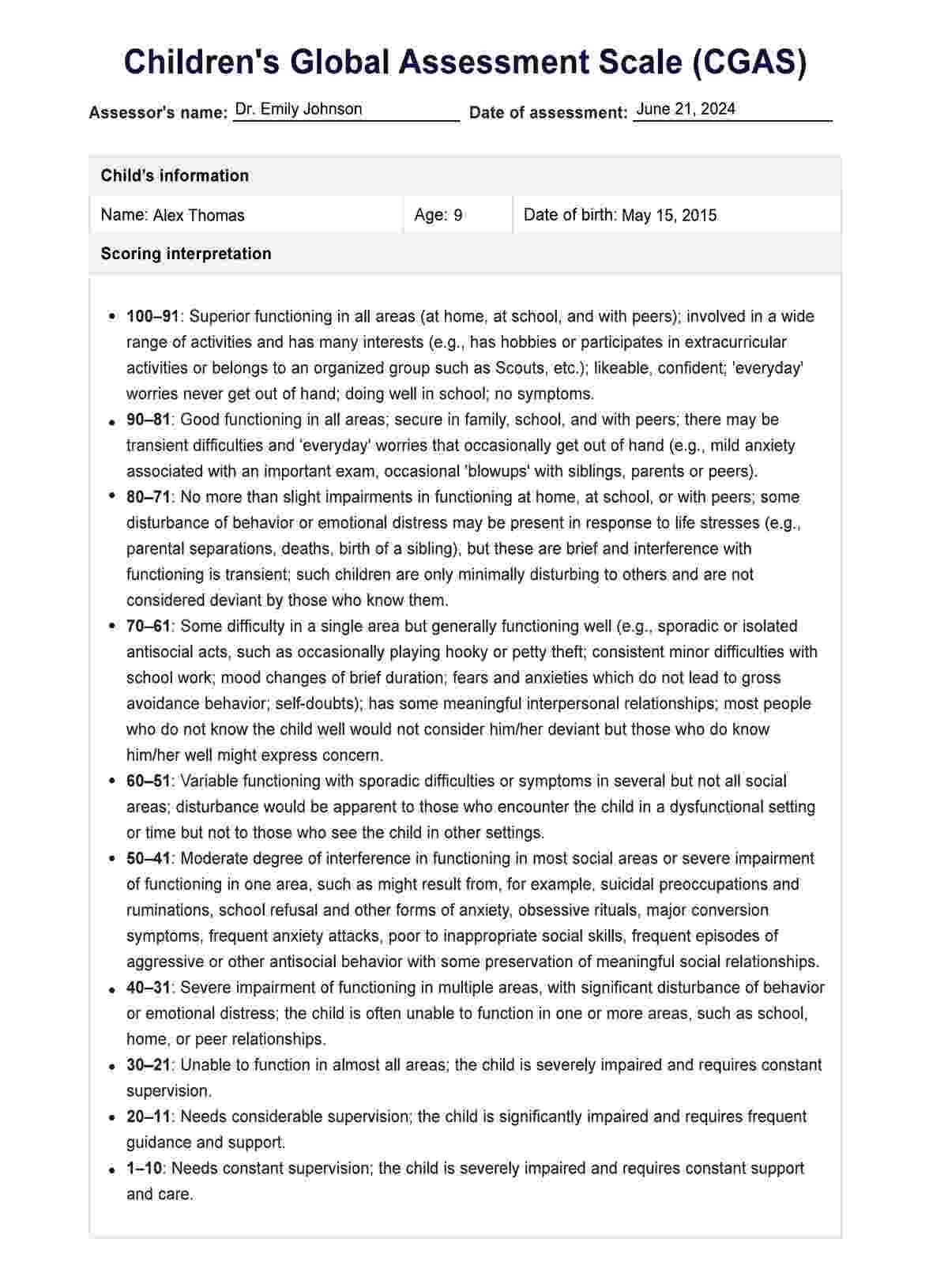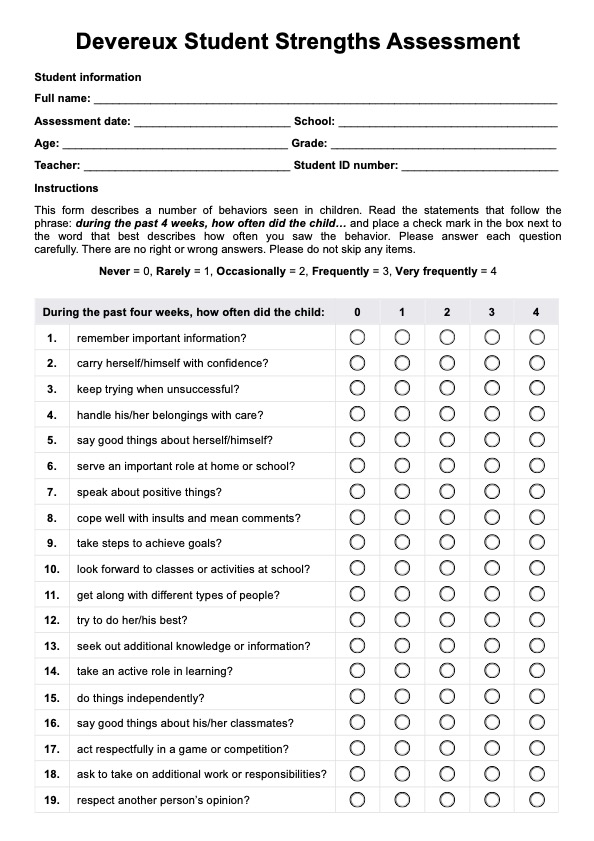CGAS Scale
Discover the Children's Global Assessment Scale (CGAS), a comprehensive tool for evaluating the functional level of children and young people. Learn how to interpret and apply the CGAS with our free template example. Ideal for health professionals using pediatric software.


What is the Children's Global Assessment Scale (CGAS)?
The Children's Global Assessment Scale (CGAS) is a widely recognized tool adapted from the Global Assessment Scale for adults, specifically designed to assess the general functioning of children and adolescents aged 4-16 years. Developed by Shaffer and colleagues at Columbia University's Department of Psychiatry, the CGAS offers a practical method for clinicians to gauge young individuals' psychological and social functioning.
Functioning on a scale from 1 to 100, the CGAS classifies children into one of ten distinct categories. These range from "needs constant supervision" for scores between 1 and 10, indicative of extremely impaired functioning, to "superior functioning" for scores between 91 and 100, where the child exhibits exceptional adaptability across all areas of life, including home, school, and peer interactions.
The assessment considers several key facets of a child's life, ensuring a comprehensive evaluation. Clinicians utilize this scale to determine a child's lowest level of functioning during a specified time frame, typically the preceding month. This approach helps identify various levels of need—from "constant supervision" to "superior functioning"—enabling targeted interventions suited to the child's
Variants of the CGAS exist to address specific populations and needs. The Developmental Disability CGAS (DD-CGAS) is adapted for children with developmental disabilities, providing a more tailored assessment for this group. The Parent-Infant Relationship Global Assessment Scale (PIRGAS) focuses on evaluating the quality of the relationship between parents and their infants, highlighting relational dynamics that can impact early development.
How are the results interpreted?
Interpreting the CGAS involves a detailed analysis of the score assigned by the clinician, which reflects the child's overall ability to function across different environments. The score is determined based on the child's lowest level of functioning during the assessment period. Here is a simplified form:
- 1-10: Needs constant supervision due to severe challenges like self-destructive behaviour or major disruption in basic cognitive processes.
- 11-20: Needs considerable supervision to ensure safety and manage behaviors that may pose risks.
- 21-30: Severe impairment; it is nearly impossible for the child to engage in most daily activities without significant support.
- 31-40: Major impairment in several areas, requiring specific interventions to manage dysfunction.
- 41-50: Obvious problems manifest as noticeable disruptions in social interactions or personal care.
- 51-60: Noticeable problems where the child shows variable functioning with sporadic difficulties.
- 61-70: Some problems in one area but generally manages well with minor issues.
- 71-80: Doing alright, with only slight impairments noticed.
- 81-90: Good functioning in all areas with only transient difficulties.
- 91-100: Superior functioning with the child excelling in personal, social, and educational aspects.
Using the CGAS relies heavily on the examiner's clinical expertise to determine the appropriate score based on the descriptors for each 10-point interval. If you want the detailed descriptions for each category, please refer to our template.
CGAS Scale Template
CGAS Scale Example
How to use our CGAS Scale template
Our CGAS Scale template is designed to streamline the assessment process for health professionals, making it easier to document and interpret the functional levels of children and adolescents. Follow these steps to effectively use the template:
Step 1: Access this template
Begin by accessing the CGAS Scale template from the Carepatron app or by clicking the download button on this page. You can also edit it on the app.
Step 2: Explain the template
Before administering the CGAS Scale, explain the purpose and structure of the template to the patient and their guardians. Clarify that the assessment will help evaluate the child's overall functioning across different environments and that the information gathered will be used to tailor interventions and support.
Step 3: Gather information and do evaluation
Collect comprehensive background information through interviews and observations over a period of one month. Document the child’s lowest level of functioning and use the template to record scores and observations accurately.
Step 4: Review, discuss, and store findings
Review the findings with the clinical team or the child's guardians, discussing the score and recommended interventions. Ensure the completed template is properly documented and stored in the patient's medical records.
Step 5: Plan follow-up
Based on the CGAS score and observations, plan follow-up assessments and interventions. Regularly re-evaluate the child's progress and adjust the treatment plan as necessary to ensure continuous improvement in their functioning and well-being.
This template ensures a standardized approach to scoring, providing consistency and reliability in assessing child and adolescent functional levels.
Benefits of using this scale
The Children's Global Assessment Scale (CGAS) offers significant benefits, making it an indispensable tool for pediatric health professionals. Here’s how it enhances care delivery:
Comprehensive overview
The CGAS provides a holistic view of a child's functional capabilities, capturing subtle nuances that might be overlooked by symptom-specific assessments. It effectively notes manifestations such as consistent minor difficulties or frequent anxiety attacks, providing a broader perspective on the child’s overall health.
Guides interventions
This scale is instrumental in pinpointing specific areas needing support, such as to maintain personal hygiene or managing isolated antisocial acts. By identifying these areas, the CGAS facilitates targeted interventions that are more effective, addressing issues highlighted in the Diagnostic and Statistical Manual of mental disorders.
Monitors progress
Regular assessments with the CGAS provide a timeline of changes in the child's functional status, offering objective data to evaluate the impact of interventions on major conversion symptoms or repeated suicide attempts. This ongoing monitoring is crucial for adapting treatment plans to better serve the child’s evolving needs.
Facilitates communication
The CGAS generates clear, categorical results that simplify communication with parents, teachers, and other care providers, ensuring everyone is informed about the child's status and needs. This is particularly important for fostering meaningful social relationships and ensuring comprehensive care coordination.
Enhances understanding and management
By providing detailed insights into the child’s condition, the CGAS helps professionals develop a deeper understanding and more effective management strategies for dealing with complex cases involving such children.
Utilizing the CGAS not only supports individualized care strategies but also enhances the overall management of children’s mental health, making it a valuable asset in pediatric healthcare settings.
Commonly asked questions
Trained health professionals such as psychologists, psychiatrists, and pediatricians are qualified to administer the CGAS.
The frequency of assessment depends on the clinical context but is typically part of an initial assessment and subsequent follow-ups to monitor progress.
The CGAS is designed for children aged 4 to 16. Other specific assessments may be more appropriate for younger children.

.jpg)























-template.jpg)













































































